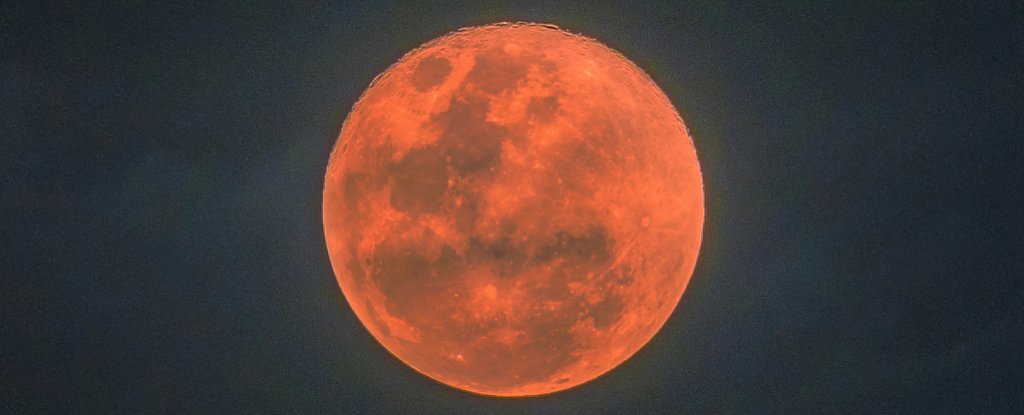
In 1110, The Moon Vanished From The Sky. We May Finally Know Why
PETER DOCKRILL
29 DECEMBER 2020
Almost a millennium ago, a major upheaval occurred in Earth's atmosphere: a giant cloud of sulphur-rich particles flowed throughout the stratosphere, turning skies dark for months or even years, before ultimately falling down to Earth.
We know this event happened because researchers have drilled and analysed ice cores - samples taken from deep within ice sheets or glaciers, which have trapped sulphur aerosols produced by volcanic eruptions reaching the stratosphere and settling back on the surface.
Ice can thus preserve evidence of volcanism over incredibly long timescales, but pinpointing the precise date of an event that shows up in the layers of an ice core is still tricky business.
In this case, scientists had assumed the sulphurous deposit was left by a major eruption unleashed in 1104 by Iceland's Hekla, a volcano sometimes called the 'Gateway to Hell'. Since the thin strip of ice ranks among the largest sulfate deposition signals of the last millennium, it sounds plausible.
Only, what if the accepted timeline of an ice core turns out to be time-warped? A few years ago, one study concluded that a timescale called the Greenland Ice Core Chronology 2005 (GICC05) was off by up to seven years in the first millennium CE, and by up to four years early in the next millennium.
Those findings, according to research published in April 2020 - led by palaeoclimatologist Sébastien Guillet from the University of Geneva in Switzerland - mean Hekla couldn't have been the culprit for the giant sulphate signal after all.
"A prominent discovery arising from this revised ice-core dating is a major and hitherto unrecognised bipolar volcanic signal with sulfate deposition starting in late 1108 or early 1109 CE and persisting until early 1113 CE in the Greenland record," Guillet and his co-authors explain in their paper, noting that evidence for the same event can also be seen in a similarly revised Antarctic ice core chronology.
To investigate what might have been responsible for leaving these ancient tracks at both the top and the bottom of the world, the team combed historical documentation, looking for medieval records of strange, dark-looking lunar eclipses that could correspond to the stratospheric haze of major eruptive events.
"The spectacular atmospheric optical phenomena associated with high-altitude volcanic aerosols have caught the attention of chroniclers since ancient times," the team writes.
"In particular, the reported brightness of lunar eclipses can be employed both to detect volcanic aerosols in the stratosphere and to quantify stratospheric optical depths following large eruptions."
According to NASA records based on astronomical retrocalculation, seven total lunar eclipses would have been observable in Europe in the first 20 years of the last millennium, between 1100 and 1120 CE.
Among these, a witness to a lunar eclipse that occurred in May 1110 wrote of the exceptional darkness of the Moon during the phenomenon.
"On the fifth night in the month of May appeared the Moon shining bright in the evening, and afterwards by little and little its light diminished, so that, as soon as night came, it was so completely extinguished withal, that neither light, nor orb, nor anything at all of it was seen," an observer wrote in the Peterborough Chronicle.
Many astronomers have since discussed this mysterious and unusually dark lunar eclipse. Centuries after it occurred, the English astronomer Georges Frederick Chambers wrote about it, saying: "It is evident that this [eclipse] was an instance of a 'black' eclipse when the Moon becomes quite invisible instead of shining with the familiar coppery hue".
Despite the event being well-known in astronomy history, though, researchers have never suggested it might have been caused by the presence of volcanic aerosols in the stratosphere, even though that's the most likely cause, the new study suggests.
"We note that no other evidence of volcanic dust veil, such as a dimming of the Sun, red twilight glows and/or reddish solar haloes, could be found during our investigations for the years 1108–1110 CE," the researchers write.
If the timing is right, then what volcano was responsible for the sulphur cloud, given Hekla is now out of the frame?
While it's impossible to know for sure, the team thinks the most probable explanation is Japan's Mount Asama, which produced a giant, months-long eruption in the year 1108 – significantly larger than a subsequent eruption in 1783 that killed over 1,400 people.
A diary entry recorded by a statesman describes the 1108 event: "There was a fire at the top of the volcano, a thick layer of ash in the governor's garden, everywhere the fields and the rice fields are rendered unfit for cultivation. We never saw that in the country. It is a very strange and rare thing."
In addition to witness accounts, the researchers also looked at tree ring evidence, which suggests 1109 CE was an exceptionally cold year (about 1 degree Celsius cooler in the Northern Hemisphere), based on significantly thinner tree rings.
Other historical documentation, in particular accounts of climatic and societal impacts in the years 1109–1111 CE, corroborate the hypothesis that an 1108 eruption (or a series of eruptions that began that year), could have led to disastrous effects on affected communities.
The researchers found an "abundance of testimonies referring to adverse weather, crop failures, and famines in these years", noting that the "assembled evidence suggests that the subsistence difficulties, which began in 1109, deepened into famine in several regions of western Europe".
Of course, those long-ago hardships can't be taken as proof of any particular eruptive event, but the researchers say all the evidence, taken together, suggests a 'forgotten' cluster of volcanic eruptions in 1108 to 1110 unleashed terrible consequences on humanity. We're only rediscovering them now.
The findings are reported in Scientific Reports.
A version of this article was originally published in May 2020.
No comments:
Post a Comment